Plant of the Week
 Eryngium yuccifolium range map. USDA PLANTS Database.
Eryngium yuccifolium range map. USDA PLANTS Database.
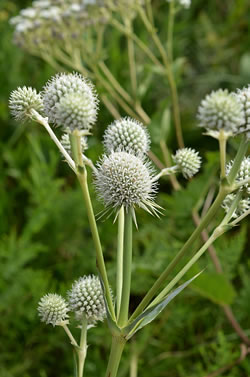 Rattlesnake Master (Eryngium yuccifolium) seeds. Photo by Christopher David Benda.
Rattlesnake Master (Eryngium yuccifolium) seeds. Photo by Christopher David Benda.
 Close-up Rattlesnake Master (Eryngium yuccifolium) flower. Photo by Christopher David Benda.
Close-up Rattlesnake Master (Eryngium yuccifolium) flower. Photo by Christopher David Benda.
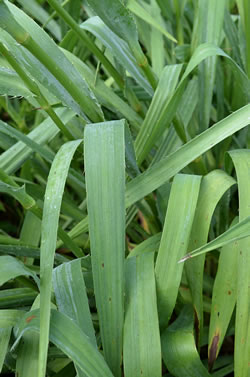 Rattlesnake Master (Eryngium yuccifolium) leaves. Photo by Christopher David Benda.
Rattlesnake Master (Eryngium yuccifolium) leaves. Photo by Christopher David Benda.
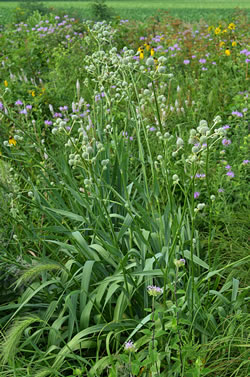 Rattlesnake Master (Eryngium yuccifolium) plants. Photo by Christopher David Benda.
Rattlesnake Master (Eryngium yuccifolium) plants. Photo by Christopher David Benda.
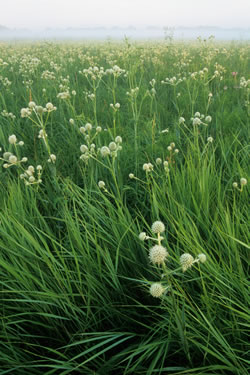 Rattlesnake Master (Eryngium yuccifolium) in prairie habitat. Photo by William Glass.
Rattlesnake Master (Eryngium yuccifolium) in prairie habitat. Photo by William Glass.
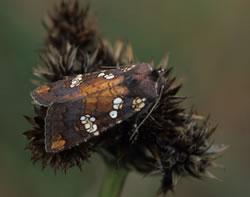 Rattlesnake master stem-borer (Papaipema eryngii) moth. Photo by William Glass.
Rattlesnake master stem-borer (Papaipema eryngii) moth. Photo by William Glass.
Rattlesnake Master (Eryngium yuccifolium L.)
By Eric Ulaszek and Christopher David Benda *
Rattlesnake master is a perennial forb that grows from a thickened, corm-like crown. When not flowering, the plant forms a rosette of long, narrow, fibrous leaves, sometimes reaching up to 30 inches in length, but usually less. The leaves of rattlesnake master have parallel veins—one of relatively few dicotyledonous plants that has parallel-veined leaves—most have net-veined leaves (think about the leaves of oak trees, sunflowers, or cabbages!). These unusual leaves, with their linear shape, odd venation, and slender filiform teeth along the margins, are reminiscent of the Spanish-dagger or yucca plant (Yucca spp.); this inspired the plant’s specific epithet, ‘yuccifolium’ which means “yucca-like leaves”.
Although the aggregation of many small flowers in dense, hemispherical heads makes rattlesnake master look like a thistle or other member of Compositae, it is unrelated to those plants. Instead, rattlesnake master is a member of the carrot family (Apiaceae or Umbelliferae). Break or crush a leaf, and the aroma will give it away. Rattlesnake master contains many of the same oils and other secondary compounds as parsley, carrot, and parsnip. The reproductive parts of rattlesnake master also indicate its relationship with carrots, particularly the paired schizocarp fruit.
Rattlesnake master flowers during summer; depending on your latitude, flowering may start in late May or early July, and may continue until early September. The hairless, glaucous flower stalks are usually less than 4 feet in height, but may reach up to five feet tall on optimal sites. Large plants may have over ten flowering stalks, but most plants produce only one or two. The slender stem leaves grow shorter as the stems get taller, until they are reduced to bracts within the inflorescence. The plants have a large rootstock. This is an adaptation that allows for water storage during summer droughts, a frequent occurrence on the open prairie. The inflorescence is open, usually consisting of three to twenty hemispherical flower heads that may be up to an inch in diameter; the heads are dense aggregations of tiny, white flowers. The flowers are surrounded by bracts and bractlets that are sharp and pointed.
In the wild, seedlings rarely flower until their third growing season, but cultivated plants often flower during the second growing season to prevent self-fertilization. The pollen grains mature several days before the stigmas are receptive. Despite this phenomenon, fertilization is easily achieved by the myriad of pollinators, particularly wasps that visit the flowers, and the seed production is close to 90 percent. The flowers each produce two fruits (schizocarps), which have serrate wings for dispersal.
Rattlesnake master thrives in full sun and has a wide range, most of the eastern United States, from southern Ontario and Florida west to Iowa, Kansas, and eastern Texas. Along the Gulf and lower Atlantic Coast, it is joined by a relative, Eryngium aquaticum, which also has monocot-like leaves. In the Midwest, rattlesnake master is a characteristic forb of tallgrass prairies, growing in a wide range of soils, but usually on calcareous, moist sites. However, rattlesnake master can also occur in glades and savannas. Southeast of the prairie regions, suitable habitat for rattlesnake master includes barrens, flatwoods, and the upper edges of seeps and swamps.
Of course, the name “rattlesnake master” prompts all kinds of suggestions as to potential medical uses. The best documented use, made by John Adair during the 1700s, describes the use of the plant’s sap as a preventative to snakebite, used during ceremonial handling of rattlesnakes. The sap and roots were also used to treat a wide variety of maladies, and as a diuretic. The Mesquakies used it in their ceremonial rattlesnake dance and used the roots to treat rattlesnake bites. The bristly flower heads are arranged like a pitchfork, suggesting a possible use as a snake stick to pin down the head of a rattlesnake. There is no evidence for the efficacy of this plant in prevention or treatment of any medical condition. Native Americans would use the fibrous leaves of this perennial plant for weaving purposes, like making sandals and baskets.
However, another use of rattlesnake master is now recognized: this distinctive plant is gaining popularity as an ornamental. It grows and flowers in most garden soils, provided it receives some sun during the middle of the day. In the garden, however, this wildflower benefits from some competition, especially from native grasses. Otherwise plants may grow very tall (over 5 feet) and the stems often fall over.
In the prairie or in the garden, rattlesnake master is a favorite of native insects. Monarch butterflies, skippers, and other butterflies visit the flower heads for nectar. Soldier beetles visit the flowers to eat pollen; major pollinators include a diversity of bees, wasps, and flies.
One specialized insect, the rattlesnake master stem-borer (Papaipema eryngii) is dependent of the rattlesnake master to complete its life-cycle; this moth’s caterpillars burrow in the stems and roots of this plant. The surviving populations of this moth are now restricted to prairie remnants that support large populations of rattlesnake master. The moth’s natural range is limited to the central United States.
Another dependent insect is the larva of a seed-eating moth (Coleotechnites eryngiella) that burrows through the flowerheads, eating seeds as it grows. Caterpillars of the black swallowtail butterfly (Papilio polyxenes) occasionally feed on the leaves, but the caterpillars prefer other members of the carrot family (both native and introduced). In our native prairies, rattlesnake master is a characteristic flowering plant that contributes greatly to insect diversity.
Although generally considered a long-lived perennial, voles and other rodents often feed on the plant’s crowns during the winter, causing local devastation where rattlesnake master is abundant.
For More Information
* Note: Eric Ulaszek and Christopher David Benda submitted articles about this species. Their write-ups were combined and both of their images were used for this article about rattlesnake master.

